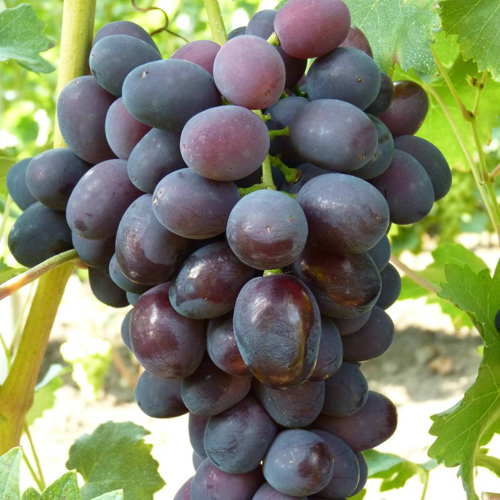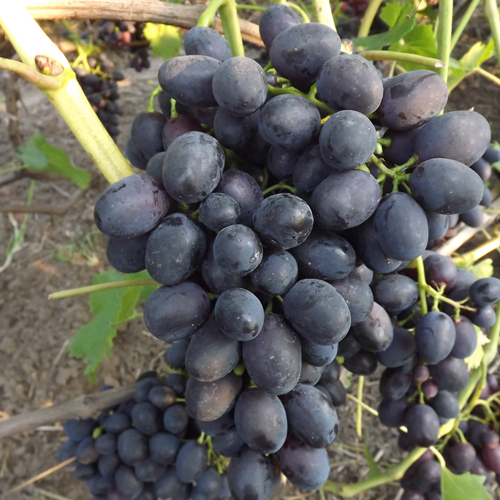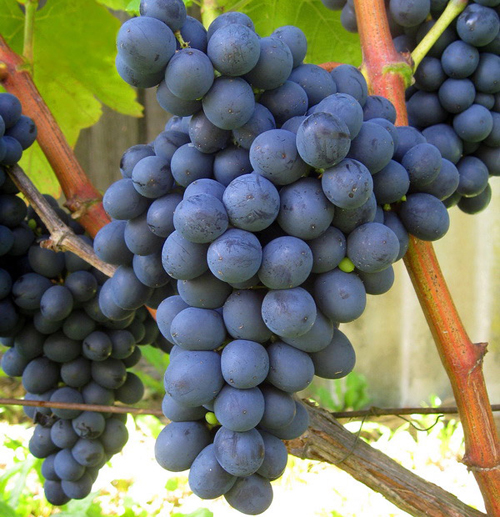Grape variety Zabava
The hybrid form of grapes Zabava was born thanks to the efforts of an amateur breeder Vitaly Zagorulko from the Ukrainian city of Zaporozhye. Very famous varieties were used as a parental pair - Laura, selection of the Odessa Institute of Viticulture and Winemaking. V.E. Tairova, and Codryanka - the pride of the Moldovan NGO "Vierul". As a result of the crossing, a variety with dark-colored berries was obtained, but in many other morphological characteristics it was similar to the maternal form. For this similarity, the people called her Laura Black, which stuck to her as a second name.
The advantages of the new generation hybrid are early ripening of fruits, their attractive appearance and good taste, high growth energy and productivity. The disadvantages include the average indicators of resistance to diseases and frost, as well as a tendency to overload the crop, which requires careful regulation. In general, our heroine can be recognized as a rather successful work of the author, which is confirmed by the significant army of her fans, who have spread this grape over the past years to numerous corners of the post-Soviet space.

Agrobiological characteristics of the variety
Bushes of Fun are characterized by strong growth of powerful shoots. The crown is shiny, light green with a slight hint of a bronze shade of the shoot axis and young leaves. The developed leaves are large, stretched in width, five-lobed with a weak degree of dissection between them. The leaf profile is funnel-shaped with lobes bending downward. The surface of the leaf blade is dark green, reticulate wrinkled. The upper side cuts are medium in depth, can take an open slot-like shape, V-shaped, or closed without a gap. The lower notches are almost invisible, most often having the appearance of an incoming corner, but they may be completely absent. The petiole notches are open, vaulted, or lyre-shaped, with a flat or pointed bottom. Petioles are not very saturated green color, thin, longer than the main vein of the leaf. The marginal teeth are mostly large, triangular with slightly pointed apices, slightly curved edges, and wide bases. The flowers of the grapes are bisexual, due to which they are pollinated much better than the maternal form - Laura, which has a functionally female type of flower. Thanks to this, the variety is relieved of problems such as peas on berries or excessive looseness of the brushes. Annual growth ripens perfectly. After that, the shoots become yellowish-brown in color.
The size of Zabava's bunches is large, their average weight is 600-800 grams, the shape is wide or cylindrical-conical, the density is moderately loose. Due to the successful structure of the brushes, the berries are not squeezed or deformed in them, which, given the high degree of their evenness, gives the bunches a very elegant and neat look. In addition to single-caliber, oval-ovoid grapes are characterized by large sizes (up to 35 mm in length and up to 22 mm in diameter) and weight (from 7 to 10 grams). Their surface is painted dark blue and covered with a dense layer of gray protective wax coating. The pulp is dense, fleshy-crunchy, neutral, balanced taste, and without bright tones in the aroma and aftertaste. The sugar content in the juice is quite high, 18–20 g / 100 ml, the titratable acidity is in the range of 6–7 g / l. The peel of the berries is quite thin, easy to chew, almost not felt when eaten. The stones are medium in size, their number rarely exceeds two, and therefore they do not have a sharply negative effect on the taste of the fruit. The general tasting ratings of the grapes are quite high, although some gourmets sometimes complain about the taste of the variety that is too simple, in their opinion.

The resulting crop is mainly used for fresh consumption.The hybrid is cultivated both on personal plots for their own consumption and on farms for commercial purposes. The bunches have a very good presentation, and are in deserved demand in the market. At the same time, due to the early ripening period, grapes enter the market during a period of relatively high prices, which makes them highly profitable for owners. In addition, it is distinguished by good transportability, without damage and shedding of berries, it transfers movement, including over long distances, which significantly expands the possibilities of its implementation. The crop of Fun is also well stored, keeping a fresh attractive appearance for a long time in optimal conditions. At home, wonderful preparations for the winter are prepared from it. Compotes, preserves, marinades are excellent in taste and color saturation, reminding in a gloomy winter of the bright colors of summer, and saturating the body with vitamins that are deficient at this time of year.
The variety is attributed to early-ripening varieties due to the short growing season that lasts from the moment the buds open to the onset of the removable ripeness of the bunches on average 100-110 days. At the same time, the calendar dates for harvesting naturally differ, depending on the geography of growth, but as a guide, it can be indicated that in the south the first bunches reach removable conditions already at the end of July. The need for heat in a hybrid for this short time is also very modest - 2150-2250 ° C. This indicator demonstrates the ability of grapes to grow and bring a normally ripe harvest far beyond the traditional wine-growing regions. The level of SAT required for it is typical for such cities as Yekaterinburg, Izhevsk, Nizhny Novgorod, not to mention the more southern latitudes. Many growers have already tested our heroine in harsh climatic conditions, including in the Moscow region, and with their successful experience confirm the possibility of cultivating it in the Non-Black Earth Region. At the same time, the only factor that can cause concern is the average degree of frost resistance of the vine. At Zabava, it does not exceed -21 ° С, and therefore its cultivation in the north is associated with the need for a very careful shelter of the aboveground part for the winter.

Probably the most important characteristic, which does not cause any complaints, but only delight and a sense of satisfaction, is the productivity of this hybrid form. 20 kilograms of excellent quality grapes, the plants "stretch" with ease, without any delays in ripening. With watering, fertilizing with mineral fertilizers and a general high agricultural background, this figure can also be increased, however, the main thing is to subtly feel where the line lies beyond which the crop variety begins to overload and the generosity of plants is abused, harming themselves. The merciless exploitation of bushes without limiting the potential yield will sooner or later lead to the most unfavorable consequences, up to the death of weakened plants in winter. And the quality of the grapes drops significantly during overload, and therefore the small size of the growing bunches, the wateriness of the berries and the inexpressive taste are a reason to think about the obvious mistakes made when standardizing the yield.
After the onset of removable maturity, the bunches of Fun can be left hanging on the vine for a long time, if, of course, the local climate allows. This can only be prevented by the proximity of frosts, when it comes to northern cultivation regions. In other places, the achievement of full ripening, and hence the accumulation of the best parameters of sugar content, will not be hindered even by heavy rains, which in other varieties could lead to cracking of the berries. For our heroine, such a problem is not typical, and this is her other valuable positive quality. Some concerns about the harvest may be inspired by wasps, for which the thin skin of the berries is not an obstacle, however, protection measures against these insects have long been worked out and are successfully used by many growers.
Agrotechnical features
The economic characteristics of the variety, like the agrobiological ones, demonstrate their strengths and not so much.There are no frankly weak features in grapes, and therefore its cultivation will not be difficult for a grower who owns at least basic ideas about the culture and the technology of its cultivation.
For good growth and fruiting, a vigorous, highly productive Zabava prefers fertile and sufficiently moist soils. Various types of chernozems will be an excellent option, however, it can grow well in the northern non-chernozem zone, provided that the soil is deoxidized and high doses of organic and mineral fertilizers are applied for planting. In the process of development, and especially after entering fruiting, it is very desirable to carry out regular feeding with moderate doses of macro- and microelements, and ideally to combine them with watering.
Planting grapes in the zone of soil contamination by root phylloxera is carried out by seedlings grafted onto phylloxera-resistant rootstocks, with which the hybrid has a high affinity. The variety rooted on its own is also excellent, however, due to the lack of data on resistance to root aphids, the establishment of self-rooted plantings on soils infected with a malicious pest carries an unjustified risk of plant death within a few years after planting. But in the endless expanses of regions unconventional for viticulture, where phylloxera is guaranteed to be absent, the reproduction of Zabava is easily carried out by rooted cuttings.
The formation of young plants depends on the chosen method of cultivation - covering or non-covering. The latter, however, is possible only in very mild climatic conditions, where the thermometer in winter is guaranteed not to drop below the critical temperature for a hybrid of -21 ° C. If there is such confidence, then the bushes are formed on a high trunk, which best meets the biological characteristics of the grapes, and therefore has an excellent effect on the quality of fruits and yield. In the vast majority of regions of cultivation, the hybrid is sheltered for the winter, for which the bushes are given stumpless, squat forms, most often in the form of an oblique cordon or a multi-arm fan. The bushes that have entered fruiting are loaded moderately, leaving 35-45 eyes when pruning with the length of the fruit arrows 6-8 buds. During the growing season, after the debris has been carried out, the number of clusters on the shoots is also thinned out in order to prevent overloading the plants.
To combat fungal diseases, Zabava, as a medium-resistant variety, is fully and comprehensively treated with fungicides during the period of the highest harmfulness of pathogens in the early stages of the growing season, and subsequently monitored grape plantations, promptly responding to possible outbreaks of the development of certain pathogens.









Excellent variety with exceptional characteristics. This grape is especially good when grown in Central Russia - where there is a large difference between day and night temperatures. Initially, I tried it in the south and, to be honest, the berries did not impress me much with either color or taste. And then, when a neighbor treated me to these grapes, I did not believe that they were the same variety - the difference was so great: the berries are dark, almost black, sweet, with a fruity aftertaste! It grows without problems - it doesn’t get sick, it blooms late - it doesn’t get under return frosts, the set is good - there are no “peas” on my bushes.